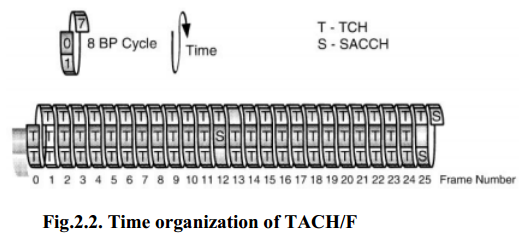What are the services offered by GSM channels?
GSM Channel Structure:
The services offered to users have four radio transmission modes, three data modes, and a speech mode. The radio transmission modes use the physical channels.
Physical Channels:
There are three kinds of physical channels, also called traffic channels (TCHs):
1. TCH/F (full rate): Transmits a speech code of 13 kbps or three data-mode rates, 12, 6, and 3.6 kbps.
%20PSTN%20user%20to%20ISDN%20user%20(b)%20GSM%20user%20to%20ISDN%20user.PNG) |
| Interconnection with ISDN (a) PSTN user to ISDN user (b) GSM user to ISDN user |
2. TCH/H (half rate): Transmits a speech code of 7 kbps or two data modes, 6 and 3.6 kbps.
3. TCH/8 (one-eighth rate): Used for low-rate signaling channels, common channels, and data channels.
Logic channels:
1. Common channels: All the common channels are embedded in different traffic channels. They are grouped by the same cycle (51 × 8 BP), where BP stands for burst period (i.e.,time slot), which is 577 µs.
2. Downlink common channels: There are five downlink unidirectional channels, shared or grouped by a TCH.
(i) Frequency correction channel (FCCH) repeats once every 51×8 BPs; used to identify a beacon frequency.
(ii)Synchronization channel (SCH) follows each FCCH slot by 8 BPs.
(iii)Broadcast control channel (BCCH) is broadcast regularly in each cell and received by all the mobile stations in the idle mode.
(iv)Paging and access grant channel (PAGCH) is used for the incoming call received at the mobile station. The access grant channel is answered from the base station and allocates a channel during the access procedure of setting up a call.
(v)Call broadcast channel (CBCH). Each cell broadcasts a short message for 2s from the network to the mobile station in idle mode. Half a downlink TCH/8 is used, and special CBCH design constraints exist because of the need for sending two channels (CBCH and BCCH) in parallel.
The mobile station (MS) finds the FCCH burst, then looks for an SCH burst on the same frequency to achieve synchronization. The MS then receives BCCH on several time slots and selects a proper cell, remaining for a period in the idle mode.
3. Uplink common channels: The random-access channel (RACH) is the only common uplink channel. RACH is the channel that the mobile station chooses to access the calls.
There are two rates: RACH/F (full rate, one time slot every 8 BP), and RACH/H (half rate, using 23 time slots in the 51 × 8 BP cycle, where 8 BP cycle [i.e. a frame] is 4.615ms).
4. Signaling channels: All the signaling channels have chosen one of the physical channels,and the logical channels names are based on their logical functions:
5. Slow Associated Control Channel (SACCH): A slow-rate TCH used for signaling transport and used for non urgent procedures, mainly handover decisions. It uses one-eighth rate. The TCH/F is always allocated with SACCH. This combined TCH and SACCH is denoted TACH/F.SACCH occupies 1 time slot (0.577 ms) in every 26 frames (4.615ms × 26). The time organization of a TACH/F is shown in Fig.2.2.
 |
| Time organization of TACH/F |
6. Fast Associated Control Channel (FACCH): Indicates cell establishment, authenticates subscribers, or commands a handover.
7. Stand-alone Dedicated Control Channel (SDCCH): Occasionally the connection between a mobile station and the network is used solely for passing signaling information and not for calls. This connection may be at the user’s demand or for other management operations such as updating the unit’s location. It operates at a very low rate and uses a TCH/8 channel. Radio slots are allocated to users only when call penetration is needed. There are two modes, dedicated and idle. The mode used depends on the uplink and the downlink. In GSM terminology, the down link is the signal transmitted from the base station to the mobile station, and the uplink is the signal transmitted in the opposite direction.
8. Voice/data channels: Each time slot of a voice channel contains 260 bits per block. The entire block contains 316 bits. Each time slot of a data channel contains 120 or 240 bits per block.

